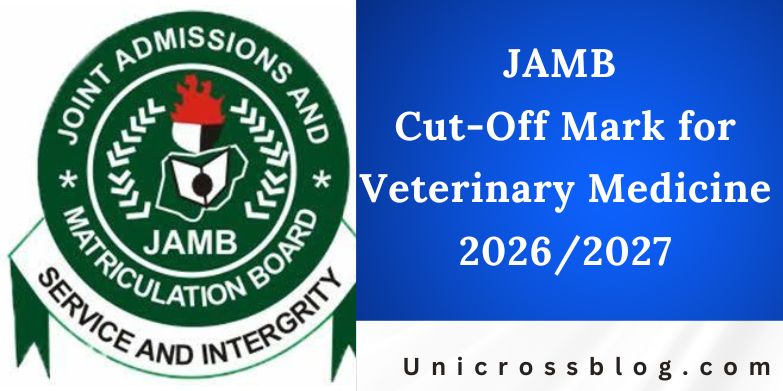Veterinary Medicine is a vital and rewarding field that focuses on the health, welfare, and treatment of animals. In Nigeria, aspiring veterinarians play a crucial role in safeguarding livestock, companion animals, and wildlife, while also contributing to public health through disease prevention and food safety. The course equips students with skills in animal anatomy, pathology, surgery, pharmacology, and epidemiology, preparing them for careers in clinical practice, research, government agencies, or agribusiness.
Admission into Veterinary Medicine programs in Nigerian universities is highly competitive, requiring strong performance in the Unified Tertiary Matriculation Examination (UTME) administered by the Joint Admissions and Matriculation Board (JAMB). The JAMB cut-off mark serves as the minimum score threshold for eligibility, but individual universities often set higher departmental benchmarks based on applicant performance and available slots. For the 2026/2027 academic session, while official announcements are pending, projections draw from recent trends where the general JAMB minimum remains at 160, but Veterinary Medicine typically demands scores between 180 and 200 or higher.
This guide provides a comprehensive overview of expected cut-off marks, admission requirements, key universities, and preparation tips. Understanding these elements early can help prospective students strategize effectively, aiming not just to meet but exceed requirements for better admission prospects. With dedication, scoring above the cut-off can open doors to prestigious programs that shape the future of animal health in Nigeria.

What is the JAMB Cut-Off Mark?
The JAMB cut-off mark is the lowest score a candidate must achieve in the UTME to qualify for post-UTME screening and potential admission into a chosen course or institution. JAMB sets a national benchmark, but universities adjust departmental cut-offs annually during policy meetings, considering factors like applicant numbers, national performance, and program capacity.
For Veterinary Medicine, the course’s competitive nature elevates the threshold. The general JAMB UTME cut-off for universities is projected to stay at 160 for 2026/2027, but this is merely the entry point. Departmental cut-offs for Veterinary Medicine are expected to range from 180 to 220, reflecting its status as a professional science program akin to human medicine. These scores ensure only well-prepared candidates proceed, as the curriculum demands rigorous scientific aptitude.
Candidates should note that admission is not automatic even after meeting the cut-off. Universities compute an aggregate score combining UTME results (often weighted at 50%), post-UTME performance (another 50%), and sometimes O’Level grades. Aiming for 250 or above in UTME significantly boosts chances, especially in top federal universities where merit lists prioritize high achievers.
Universities Offering Veterinary Medicine in Nigeria
Nigeria boasts several accredited universities offering Veterinary Medicine, regulated by the Veterinary Council of Nigeria (VCN) and the National Universities Commission (NUC). These institutions provide a Doctor of Veterinary Medicine (DVM) degree, typically spanning six years, including a one-year internship. Below is a table summarizing key universities, their locations, and expected JAMB cut-off marks for the 2026/2027 session, based on 2025/2026 patterns.
| University Name | Location | Expected JAMB Cut-Off Mark | Notable Features |
|---|---|---|---|
| University of Ibadan (UI) | Ibadan, Oyo State | 200 | Oldest program; strong research focus; stable academic calendar. |
| University of Nigeria, Nsukka (UNN) | Nsukka, Enugu State | 200 | Renowned faculty; emphasis on clinical training; high graduate employability. |
| Ahmadu Bello University (ABU) | Zaria, Kaduna State | 180-200 | Largest veterinary school; extensive farm attachments; affordable fees. |
| University of Ilorin (UNILORIN) | Ilorin, Kwara State | 200 | Modern facilities; no strikes history; balanced curriculum. |
| University of Benin (UNIBEN) | Benin City, Edo State | 200 | Integrated teaching hospital; focus on tropical diseases. |
| Usmanu Danfodiyo University (UDUSOK) | Sokoto, Sokoto State | 180 | Northern hub; community outreach programs; lower competition. |
| University of Maiduguri (UNIMAID) | Maiduguri, Borno State | 180 | Resilient despite challenges; practical wildlife modules. |
| Federal University of Agriculture, Abeokuta (FUNAAB) | Abeokuta, Ogun State | 180-200 | Agriculture-integrated; hands-on livestock management. |
| Michael Okpara University of Agriculture (MOUAU) | Umudike, Abia State | 180 | Eastern agricultural focus; entrepreneurship training. |
| University of Abuja (UNIABUJA) | Abuja, FCT | 180-200 | Urban access; policy-oriented research. |
These universities were selected for their accreditation and consistent performance. Prospective students should verify updates via official portals, as cut-offs can fluctuate by 10-20 points based on the year’s applicant pool.
Admission Requirements for Veterinary Medicine
To secure a spot in Veterinary Medicine, candidates must fulfill JAMB UTME, O’Level, and post-UTME criteria. Here’s a breakdown:
JAMB UTME Requirements
- Minimum Age: 16 years by admission year.
- Subject Combination: English Language (compulsory), Biology, Chemistry, and Physics. These subjects test foundational sciences essential for veterinary studies.
- Score Threshold: As noted, 180-200 minimum, with top schools favoring 220+.
O’Level Requirements
Candidates need at least five credit passes in WAEC, NECO, or equivalent exams, obtained in no more than two sittings. Required subjects include:
- English Language
- Mathematics
- Biology
- Chemistry
- Physics
Grades of C6 or better are ideal, as some universities compute O’Level points into the aggregate (e.g., A1 = 10 points, C6 = 2 points).
Direct Entry Requirements
For holders of advanced qualifications:
- A’Level passes in Chemistry, Biology/Zoology, and Physics/Mathematics.
- National Diploma (ND) or Higher National Diploma (HND) in relevant fields with upper credit.
- Interim Joint Matriculation Board (IJMB) or Joint Universities Preliminary Examinations Board (JUPEB) with strong grades. Direct Entry candidates enter at 200 or 300 level, shortening the program.
Post-UTME Screening
Most universities conduct aptitude tests or interviews post-UTME. Preparation involves reviewing UTME subjects deeply. Aggregate calculation example: (UTME/8) + Post-UTME score + O’Level bonus. A total of 60-70% is often needed for merit admission.
How Cut-Off Marks Are Determined
JAMB’s national policy meeting, held annually post-UTME results, sets benchmarks. Universities then propose departmental figures, approved based on:
- Number of applicants versus slots (Veterinary Medicine has limited seats, ~50-100 per university).
- Previous year’s performance data.
- Government quotas for catchment areas, educationally less-developed states, and vice chancellor’s discretion.
For 2026/2027, expect stability around 180-200, but inflation in applicant quality could raise it. Monitoring JAMB’s official releases in mid-2026 is essential.
Preparation Tips for JAMB UTME
Success in Veterinary Medicine admission starts with targeted preparation:
- Study Plan: Allocate time daily to each subject, using JAMB syllabi. Focus on Biology (40% weight) for animal physiology topics.
- Past Questions: Practice 10-15 years of JAMB papers to master patterns.
- Mock Exams: Simulate test conditions to build stamina.
- Tutors/Resources: Join coaching centers or use apps for interactive learning.
- Health Balance: Maintain sleep, diet, and exercise to peak on exam day. Scoring 250+ requires consistent effort; consider change of course if initial targets falter.
Veterinary Medicine demands passion for animals and resilience, but the rewards, including salaries starting at NGN 200,000 monthly for fresh graduates, make it worthwhile.
READ ALSO: JAMB Cut-Off Mark for Anatomy 2026/2027
FAQs
What is the minimum JAMB score for Veterinary Medicine in 2026/2027?
The general JAMB minimum is 160, but departmental cut-offs for Veterinary Medicine are expected at 180-200. Aim higher for competitiveness.
Can I gain admission with exactly 180 in JAMB?
Possible in less competitive schools like UNIMAID, but aggregate with post-UTME matters. Scores above 200 improve odds.
What if I don’t meet the cut-off?
Options include changing to related courses like Animal Science (cut-off ~160), retaking JAMB, or applying via Direct Entry later.
How many universities offer Veterinary Medicine in Nigeria?
About 10-12 accredited ones, listed in the table above. All are VCN-approved for professional practice.
Is Veterinary Medicine more competitive than Nursing?
Yes, due to fewer slots and science intensity; it rivals Medicine in demand but has broader career paths.
When will 2026/2027 cut-offs be announced?
Typically July-August 2026, post-UTME policy meeting. Check JAMB and university sites regularly.






